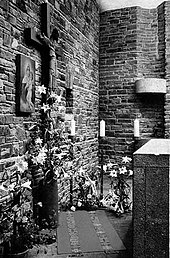Adoration Church (Schoenstatt)
The Adoration Church on Mount Schoenstatt is one of the Holy Trinity consecrated Catholic Church on Mount Schoenstatt in Vallendar . It was built from 1965 to 1968 according to plans by Alexander Freiherr von Branca . Due to its massive natural stone construction, it has a fortress-like character and its appearance symbolizes a fortress of God .
Alongside the Original Shrine , it is the second local center of the international Schoenstatt Movement .
architecture
The Adoration Church is located on the Schoenstatt Mountain high above the Original Shrine in the valley and can be recognized from afar as a massive building.
The architecture is inspired by medieval castles that abound on the hills of the Rhine valley can be found. The external appearance is dominated by quarry stone cladding and three 20 m high towers as a symbol of the Trinity to which the church is consecrated. As God's castle, the church should testify to the steadfastness of faith and radiate peace and security inside.
On the raised church square there is a fountain with seven water basins, which are surmounted by a cross. They symbolize the seven sacraments of the church, which go out from the cross like "rivers of living water" ( Jn 7:30 EU ).
In an auditorium under the church, congresses such as the October week, the annual meeting of those responsible for the Schoenstatt Movement and other events are held.
Surroundings
The house of the Adoration Sisters who look after the church is attached directly to the Adoration Church and connected to it via a connecting structure .
The nearby Pater Kentenich House was built in 1985 by the same architect and has a similar appearance due to the quarry stone cladding, but it is a single-storey low-rise building in the shape of a cross. A poplar avenue lies between the two buildings, the shape and effect of which is reminiscent of an Italian cypress avenue.
history
At the beginning of the Second World War , the founder of the Schoenstatt Movement, Father Josef Kentenich , vowed to build a Church of Adoration as a memorial and thanksgiving meal , if the Schoenstatt Movement survived the persecution under National Socialism at the intercession of the Blessed Mother Mary .
"[When Our Lady] leads us victoriously through the new dangers and, despite all obstacles, gives us the opportunity to do justice to our mission, we want to erect a new monument to her that will proclaim her power and goodness to all future generations."
The first planning for the building began as early as Christmas 1939, for which the Adoration Sisters of the Schoenstatt Sisters of Mary were particularly involved .
Kentenich was imprisoned in the Dachau concentration camp from 1942 to 1945 and had an imprisoned Czech architect draft the first plans for the Adoration Church as the "center of a holy city on the mountain". No houses in Schoenstatt were damaged during the war and Kentenich returned soon after the war ended. Thereupon the community of the Schoenstatt Sisters of Mary vowed to have the Adoration Church built on October 18, 1945.
In the post-war period, however, the construction plans could not be implemented directly and the conflict between Schoenstatt and the Church caused a further delay.
In 1960, the Munich architect Alexander Freiherr von Branca was commissioned with the planning and construction work began in 1965.
Father Kentenich described the Church of Adoration on July 9, 1967:
“Our church is a castle of God. It wants to be the dwelling of the Triune God. The triune God, the Father, the Son and the Holy Spirit lives and enthrones here. But wherever the Triune God dwells and is enthroned, the Mother of God also has a seat and a voice. Therefore, of course, in our Trinity Cathedral, in our Trinity Castle, the Mother of God as our Mother Thrice Admirable, Queen and Victor of Schoenstatt has a place of honor. "
After its completion, the church was consecrated to the Holy Trinity on June 9, 1968 by Bishop Bernhard Stein of Trier .
On September 15, 1968, Father Kentenich celebrated Holy Mass for the first time in the Adoration Church and died unexpectedly after the service in the sacristy . He was buried here on September 20, the former sacristy is known today as the founder's chapel . The sarcophagus bears the inscription Dilexit Ecclesiam ( Latin for "he loved the church").
literature
- K. Leydecker, E. Santifaller: Construction site home. Architecture guide Rhineland-Palatinate 1945-2005 . Ed .: Stiftung Baukultur Rheinland-Pfalz. Schnell & Steiner, 2005, ISBN 3-7954-1759-7 .
- Meeting place Father Josef Kentenich, Vallendar . In: Detail: Building with natural stone . Issue 4, April 1991, pp. 390 – BI-IV ( detail.de ).
- M. Pia Buesge: Adoration Church . In: Hubertus Brantzen (Ed.): Schoenstatt Lexicon: Facts - Ideas - Life . 2nd unchanged edition. Patris-Verlag, Vallendar 2002, ISBN 3-87620-195-0 ( moriah.de ).
Web links
- Henner Herrmanns: Sacred building. In: ARCHBLOG. Retrieved October 21, 2012 .
- Meeting place for Father Josef Kentenich. In: arch INFORM .
- cath. Church of Adoration Most Holy Trinity . In: Kirchbau.de
Coordinates: 50 ° 24 '26.8 " N , 7 ° 38' 7.9" E


